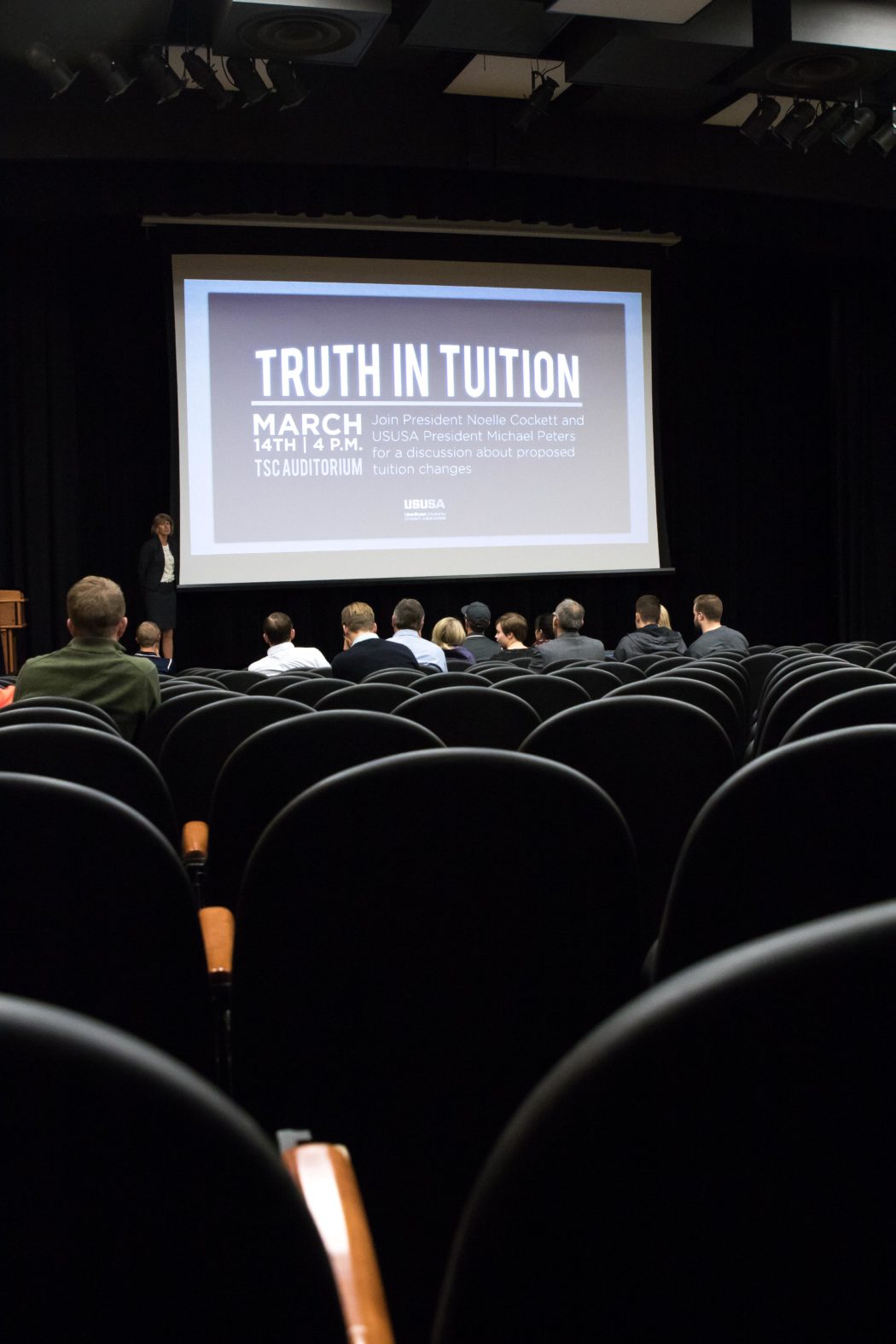Students should expect to see 2.8 percent tuition increase
Students should expect a 2.8 percent increase in their tuition, Utah State University President Noelle Cockett said at a town hall in the Taggart Student Center Ballroom Wednesday morning.
The meeting was held just hours before the university shut down many of its facilities due to the Coronavirus Disease or COVID-19.
This will be the fourth year in a row USU has raised tuition, following a 3.1 percent increase for the 2019 to 2020 school year. However, USU Student Association Executive Council President Sami Ahmed stressed there is some misunderstanding surrounding the process of raising tuition.
“I think some of the misunderstanding we have about tuition is we think it’s university administrators sitting in a room going, ‘Where can we go on vacation this year, let’s raise tuition,’” Ahmed said. “As we’ll see, that’s really not true.”
The meeting, which was broadcasted for USU campuses statewide, was focused on transparency and informing students about what’s happening to their tuition dollars. A tuition meeting is required by the state, Cockett said. She also said any public institution planning to raise costs must explain their decision-making process.
Tuition increases will be $91 a semester for students with residency. Current resident tuition is $3,274. Increases for non-residents will be $295 a semester. Non-resident tuition is currently $10,543.
“If you look at this year’s percentage of 2.8, you see this is the lowest increase in 20 years,” Cockett said. “This is the lowest increase we’ve ever done.”
Tuition increases will be used for USU salary increases, faculty promotions, internal service fees and need-based scholarships.
The biggest plot of money will be going toward salaries for faculty, advisors and facilities. According to Cockett, the state legislature decides how much state employees can earn as an increase. However, the state only provides 75 percent of the funding for higher education salary increases and asks colleges and universities to take 25 percent of salary increases out of tuition.
The second big expense will go toward promotions, which is not covered by the state, Cockett said. She added there are only two times in a professor’s career that they are actually promoted, which is why it’s essential they get those raises.
“We want to reward and adjust their salary to say, ‘You are truly someone we want, we respect and we value,’” Cockett said. “These are very big moments in our faculty’s lives.”
The third expense, the internal service fee, is also not covered by the state legislature. The internal service fee, or Utah’s risk management office, is USU’s insurance policy. “Just like all insurance companies, from time to time, they raise the premiums,” Cockett said. “That is what’s happening to us this year.”
The final expense, need-based scholarships, was “a hard lesson,” she said.
“When you raise tuition, if you don’t add more money to the scholarship budget, need-based students will not be covered,” Cockett said. As a result, USU is now hoping to backtrack and fully fund scholarships that didn’t get funding in the past.
USUSA Executive Council Vice President Dexton Lake also presented an increase in student fees for the 2020 to 2021 school year. The fees include a $1 per student increase that will go toward the library, a 49 cent increase for Counseling and Psychological Services and a $2.97 increase for the Student Health and Wellness Center.
Lake said one of his initiatives as chairman of the University Student Fee Board for 2019 to 2020 year was to make fees easily visible for students. As a result, he helped create a student fee page under the “MyUSU” portal.
“We are making great strides in making student fees more transparent,” he said.
USU freshman Kaylee Loveridge said she felt like Cockett covered everything she wanted to know and the presentation was helpful.
“As much as I don’t want tuition raised, I can understand the importance of salary raises and stuff like that,” Loveridge said. “I would want that as an employee.”
Loveridge said she would point out how important promotions are to other students who might be angry at the increase, and how the school shouldn’t want professors to leave over lack of funding.
Students in USU Eastern, Moab and Blanding campuses will also get a 2.8 percent increase.
However, students with 65 or fewer credits on those campuses will get a 3.5 percent increase, resulting in a $61 change for residents, and a $183 change for non-residents. The higher percentage is to compensate for the fact that tuition in Eastern, Moab and Blanding is nearly half of USU.
The final decision on tuition increases will be made by the Utah State Board of Regents on March 26.
@cripe_taylor

